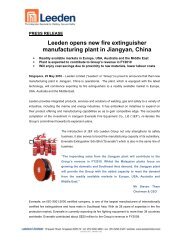Annual Report 2010 - Leeden Limited
Annual Report 2010 - Leeden Limited
Annual Report 2010 - Leeden Limited
Create successful ePaper yourself
Turn your PDF publications into a flip-book with our unique Google optimized e-Paper software.
A Stronger <strong>Leeden</strong> in Asia.Notes to the Financial Statementsfor the Financial Year ended 31 December <strong>2010</strong>2. Summary of significant accounting policies (cont’d)2.11 Intangible assets(b)Other intangible assets(ii)Customer relationshipsCustomer relationships were acquired in business combinations. The useful lives of these intangible assetsare assessed to be 7 to 10 years based on average number of years the customers have been with theacquired companies and are amortised on a straight-line basis.(iii)Club membership2.12 Impairment of non-financial assetsClub membership was acquired separately and is amortised on a straight line basis over its finite useful lifeof 90 years.The Group assesses at each reporting date whether there is an indication that an asset may be impaired. If any suchindication exists, or when an annual impairment assessment for an asset is required, the Group makes an estimate of theasset’s recoverable amount.An asset’s recoverable amount is the higher of an asset’s or cash-generating unit’s fair value less costs to sell and itsvalue in use and is determined for an individual asset, unless the asset does not generate cash inflows that are largelyindependent of those from other assets. Where the carrying amount of an asset or cash-generating unit exceeds itsrecoverable amount, the asset is considered impaired and is written down to its recoverable amount. In assessing valuein use, the estimated future cash flows expected to be generated by the asset are discounted to their present valueusing a pre-tax discount rate that reflects current market assessments of the time value of money and the risks specificto the asset. In determining fair value less costs to sell, an appropriate valuation model is used. These calculations arecorroborated by valuation multiples, quoted share prices for publicly traded subsidiary companies or other available fairvalue indicators.Impairment losses of continuing operations are recognised in profit or loss in those expense categories consistent withthe function of the impaired asset, except for assets that are previously revalued where the revaluation was taken to othercomprehensive income. In this case the impairment is also recognised in other comprehensive income up to the amountof any previous revaluation.For assets excluding goodwill, an assessment is made at each reporting date as to whether there is any indication thatpreviously recognised impairment losses may no longer exist or may have decreased. If such indication exists, theGroup estimates the asset’s or cash-generating unit’s recoverable amount. A previously recognised impairment loss isreversed only if there has been a change in the estimates used to determine the asset’s recoverable amount since thelast impairment loss was recognised. If that is the case, the carrying amount of the asset is increased to its recoverableamount. That increase cannot exceed the carrying amount that would have been determined, net of depreciation, had noimpairment loss been recognised previously. Such reversal is recognised in the profit or loss unless the asset is measuredat revalued amount, in which case the reversal is treated as a revaluation increase.2.13 Financial assetsFinancial assets are recognised on the balance sheet when, and only when, the Group becomes a party to the contractualprovisions of the financial instrument. The Group determines the classification of its financial assets at initialrecognition.When financial assets are recognised initially, they are measured at fair value, plus, in the case of financial assets not atfair value through profit or loss, directly attributable transaction costs.The subsequent measurement of financial assets depends on their classification as follows:54





